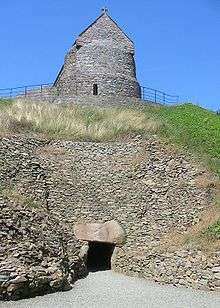La Hougue Bie
La Hougue Bie is a historic site, with museum, in the Jersey parish of Grouville. La Hougue Bie is depicted on the 2010 issue Jersey 1 pound note.
 | |

| |
| Coordinates | 49.2006°N 2.0638°W |
|---|---|
| Public transit access | Bus route 13[1] |
| Nearest car park | On site (no charge) |
| Website | www |
Toponymy
Hougue is a Jèrriais/Cotentin variant form of the more common Norman form Hogue. It means "heap", "how", mound" and comes from the Old Norse word haugr meaning about the same thing.[2] Bie is of uncertain origin. The legend of La Hougue Bie connects it with the Seigneur of Hambye in the Cotentin; an Old Norse origin may connect it to -by toponyms in Great Britain; or it may be connected to the Jèrriais word bié (variant spelling for biez "leat").[3] There are several hamlets called La Bie in Normandy (Ex La Bie, or La By(e), Grumesnil), that is never confused with Le Bié (Ex : Le Vieux-Bié, Les planteis du Viez Bié, 1263, Gournay-en-Bray). La Hougue Bie refers probably to "a building on the earth mound".
Passage grave
The site consists of an 18.6 metre long passage chamber covered by a 12.2 metre high earth mound. The site was first excavated in 1925 by the Société Jersiaise. Fragments of twenty vase supports were found along with the scattered remains of at least eight individuals.[4] Gravegoods, mostly pottery, were also present. At some time in the past, the site had evidently been entered and ransacked. On top of the mound were built two Medieval chapels. The Channel Islands have five passage graves with side chambers (La Hougue Bie, Faldouet and Grantez in Jersey, La Varde and Le Déhus in Guernsey).
La Hougue Bie is a Neolithic ritual site which was in use around 3500 BC. In Western Europe, it is one of the largest and best preserved passage graves and the most impressive and best preserved monument of Armorican Passage Grave group. Although they are termed "passage graves", they were ceremonial sites, whose function was more similar to churches or cathedrals, where burials were incidental. Since the excavations and restoration of the original entrance of the passage observations from inside the tomb at sunrise on the spring and autumn equinox have revealed that the orientation of the passage, probably fortuitously,[5] allows the sun's rays to shine through to the chamber entering the back recess of the terminal cell. Although many passage graves showed evidence of continued activity into the Late Neolithic period, La Hougue Bie was abandoned before that time.[6][7][8]
Chapels and Prince's Tower

Atop the mound are two medieval chapels, one from the 12th Century and the other from the 16th Century. This building complex has been altered a great deal through its history – including being engulfed for a period by the Prince’s Tower. Construction of this tower was started in 1792 by Philippe d'Auvergne, who justified the work by erecting a signal station on the tower as the hub of an island-wide communication system. The building was demolished in 1924.[9]
World War II
During World War II it was used as a key lookout point, and an underground command bunker was built in the mound and adjacent. This structure is open to the public, and houses an exhibition commemorating the workers from across Europe forced to build defences in Jersey during the German occupation.
Museum
The site, which is managed by Jersey Heritage, also houses the island's Archeology and Geology Museum. In that section, there is a display dedicated to the Jersey Mummy.
See also
- Archaeology of the Channel Islands
- Jersey Dolmens
- Tumulus
References
- wave. "Liberty Bus -". www.libertybus.je. Retrieved 30 July 2018.
- "Old Norse Words in the Norman Dialect". viking.no. Retrieved 30 July 2018.
- Jersey Place Names, Jersey, 1986, ISBN 0-901897-17-5
- Percival, Jeremy. "La Hougue Bie". www.prehistoricjersey.net. Retrieved 30 July 2018.
- Le Conte, David (2008). Orientations of Channel Islands Megalithic Tombs - Further observations, La Société Guernesiaise Report and Transactions, Vol XXVI, Part III, pp414-417
- Mark Patton (1993). Statements in Stone: Monuments and Society in Neolithic Europe. Routledge (UK). ISBN 0415067294.
- John G. Evans (2003). Environmental Archaeology and the Social Order. Routledge (UK). ISBN 0415304032.
- Hundreds expected at burial site BBC News, (19 March 2005).
- "The Prince's Tower – La Tour d'Auvergne" (PDF). Retrieved 17 August 2020.
Further reading
- Nash, G.H. 1997. Experiencing Space and Symmetry: The Use, Destruction and Abandonment of La Hougue Bie Neolithic Passage Grave, Jersey in G.H. Nash (ed.) Semiotics and Landscape: The Archaeology of Mind. Oxford: BAR International Series 661. 105–118.
- Nash, G.H. 1998. Fourth interim report on the facade area of La Hougue Bie Passage Grave, Jersey. Société Jersiaise Journal. Vol. 27. pt. 2. 317–330.
- Nash, G.H. 1999. Fifth interim report on the facade and entrance areas of La Hougue Bie Passage Grave, Jersey. Société Jersiaise Journal. Vol. 28, pt. 3. 491–509.
- The Archaeology of the Channel Islands. Vol. 2: The Bailiwick of Jersey by Jacquetta Hawkes (1939)
- The Prehistoric Foundations of Europe to the Mycenean Age, 1940, C. F. C. Hawkes
- The Archaeology and Early History of the Channel Islands, Heather Sebire, 2005.
- Dolmens of Jersey: A Guide, James Hibbs (1988).
- A Guide to The Dolmens of Jersey, Peter Hunt, Société Jersiaise, 1998.
- La Hougue Bie, Jersey – A Study of the Neolithic Tomb, Medieval Chapel and Prince's Tower, Including an Account of the 1991–94 Excavations., Mark Patton, Warwick Rodwell, Olga Finch, 1999. ISBN 978-0-901897-29-9.
- The Channel Islands, An Archaeological Guide, David Johnston, 1981
- The Archaeology of the Channel Islands, Peter Johnston, 1986